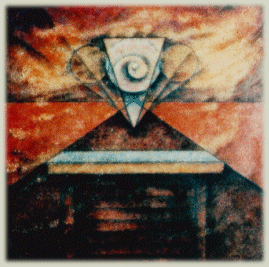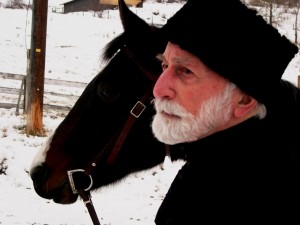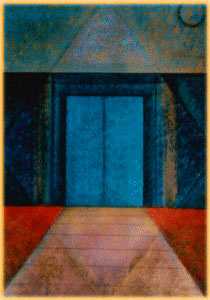Introduction to Ahmsta Kebzeh
Ancient Spiritual Discipline of Caucasus Mountains – by Murat Yagan
 In 1984, when I published my booklet (later expanded into a book) on longevity and well-being, as observed in the Caucasus and known about by the rest of the world,* I expressed the importance and place of the spiritual discipline of the peoples of the Caucasus in their achieving a long and active life. In that booklet I also mentioned briefly what this discipline was like.
In 1984, when I published my booklet (later expanded into a book) on longevity and well-being, as observed in the Caucasus and known about by the rest of the world,* I expressed the importance and place of the spiritual discipline of the peoples of the Caucasus in their achieving a long and active life. In that booklet I also mentioned briefly what this discipline was like.
Ahmsta Kebzeh, also called by outsiders in the Old World Caucasian Yoga, is a tradition peculiar to the mountaineers of Caucasus, who are in general called Circassians by Europeans. This tradition was preserved mostly in the higher mountainous parts of Caucasus until recently and started fading away at the beginning of the twentieth century as a result of invasion of Caucasus by Russia. Today it is very difficult to find anything but traces of it in communities, and very rarely possible to meet some old old-timers who can manifest some knowledge about it. It is one anthropological issue which is passed away, or at the very least, may find its place among the items of museums.
 I happen to be one of those rare Circassian Elders who lived and was trained in it up to a certain extent and who is still alive today. Seeing that in the West within the last three, four decades there developed an interest in the ancient traditions of mankind, wherever it might be on Earth, and a group of seekers forming a circle around me, I started to transfer to them whatever I had. This process started in 1975. Transcripts of talks, seminars, workshops, and evening classes, put together, formed some four thousand typed pages. Recently they organised, and registered themselves into a non-profit society under the name, “Kebzeh Foundation of Canada.” They started their own publishing company, deciding to activate and promote the teachings of Ahmsta Kebzeh and prevent its dying away unknown to the world at a time when the planet needs so much an awakening to and attainment of human potential, to enable human beings to live abundant life on a globe which is in the process of losing its resources to support its population.
I happen to be one of those rare Circassian Elders who lived and was trained in it up to a certain extent and who is still alive today. Seeing that in the West within the last three, four decades there developed an interest in the ancient traditions of mankind, wherever it might be on Earth, and a group of seekers forming a circle around me, I started to transfer to them whatever I had. This process started in 1975. Transcripts of talks, seminars, workshops, and evening classes, put together, formed some four thousand typed pages. Recently they organised, and registered themselves into a non-profit society under the name, “Kebzeh Foundation of Canada.” They started their own publishing company, deciding to activate and promote the teachings of Ahmsta Kebzeh and prevent its dying away unknown to the world at a time when the planet needs so much an awakening to and attainment of human potential, to enable human beings to live abundant life on a globe which is in the process of losing its resources to support its population.
This is an introduction to Ahmsta Kebzeh. To cover the whole teaching of it many, many, books, in various sizes, have to follow to complete the intellectual part of its teaching only. As for the applied part of it, personal involvement in it will be needed, as is the case in any experiential and processal learning – such as learning how to swim, how to play an instrument of music, or how to ride a bike. No matter how much you study the intellectual, theoretical part of it, unless you get involved also physically and personally in doing it, you cannot learn it.
Ahmsta Kebzeh is a science of living abundantly, using all human faculties as a whole, fully and wholistically. It is peculiar to Circassian people of Caucasus but in the past millennia had also its effects on other people living in Greater Caucasus in general.
 Circassians are composed mainly of nineteen different Tribes, and I belong to the one which is called Abkhazian. Although Ahmsta Kebzeh belongs in general to all Circassians and is quite the same in principles, it displays some differences from tribe to tribe, mostly due to change in altitudes; to the effect that among tribes higher in altitudes it was preserved more unchanged through millennia compared with the ones living closer to heavier traffic. Since the languages of Circassian tribes also differ from each other, some original words used in the teaching and versions of the topics I am relating here are according to their use in the Abkhazian version to which I belong. Further more, because I belong to the high mountain group, Abazas, I am relating to that group all my source.
Circassians are composed mainly of nineteen different Tribes, and I belong to the one which is called Abkhazian. Although Ahmsta Kebzeh belongs in general to all Circassians and is quite the same in principles, it displays some differences from tribe to tribe, mostly due to change in altitudes; to the effect that among tribes higher in altitudes it was preserved more unchanged through millennia compared with the ones living closer to heavier traffic. Since the languages of Circassian tribes also differ from each other, some original words used in the teaching and versions of the topics I am relating here are according to their use in the Abkhazian version to which I belong. Further more, because I belong to the high mountain group, Abazas, I am relating to that group all my source.
To be more precise, I am an Abkhazian from the group called Abazas who live on Caucasian Sierra at the place called Ashkhara, between Mount Elbruz and Mount Kazbek.
The Content of Kebzeh
Kebzeh consists of three levels of teaching and application. From lower to higher they are:
Aleishwe
Kebzeh
Ahmsta Kebzeh
1. Aleishwe (Etiquette). This is the level of edification which regulates social properness. It can be expressed by the name Etiquette. It is the rules and habits concerning personal relationships; rules about everything which is part of daily life; rules and ways concerning work, dressing, horseback riding, greeting each other and meeting people for the first time; ceremonial rules regulating weddings, funerals, paying visits to each other to observe special occasions, and so on.
2. Kebzeh (Tradition, social concepts and rules). This is the level of edification which regulates the knowledge necessary in the administrative field. As the social system in Caucasus was feudal, there is a strictly established Caste classification, expressed in five main categories: 1) Rulers, 2) Administrators, 3) Nobles, 4) People, 5) Serfs.
The second class down from the top is the class which executes the ruling of the Ruler. The discipline of Kebzeh is given to this class. It consists of all the education necessary to cultivate this class of people to perform efficiently the function of administering.
The third class down from the top, which constitutes the nobles, is the class from which administrators and rulers are promoted when there is a shortage.
The training in these two categories is done by intellectual teaching and application in the field of action. The family and the community in which a child exists from birth to death is the milieu to embrace him, providing him with everything he needs to exist, to grow, and to be raised and edified. The homogeneity of concepts and judgements of value is the most efficient teacher, trainer, and coach in the community. The whole community with its living rooms, dining tables, farming fields, gathering and dancing grounds, sporting fields, riding rings, martial arts grounds, workshops, fire-side lecturings, hunting parties, festivity meetings, toasting ceremonies, wedding parties, funerals, and all sorts of possible social activities, becomes a huge and unlimited classroom for a growing child.
The teaching and training received from community develops further when the individual gets involved in public office and grows in it backed up by the same common teacher.
3. Ahmsta Kebzeh (Tradition of the Elite). This is the part of Kebzeh the explorers from the West, starting from early fifteenth century, called The Caucasian Yoga. The teaching and training of Ahmsta Kebzeh was given exclusively to the children of the ruling class, and in exceptional cases to anybody who was deemed to be ready – in human evolution – to receive it, by the Source of the teaching.
Although this a short introduction to Kebzeh and it is not possible to go into detailed explanations within the scope of it, as I didn’t in the preceding two paragraphs, I shall give a little more explanation on Ahmsta Kebzeh to be able to give some idea of what really it is about.
